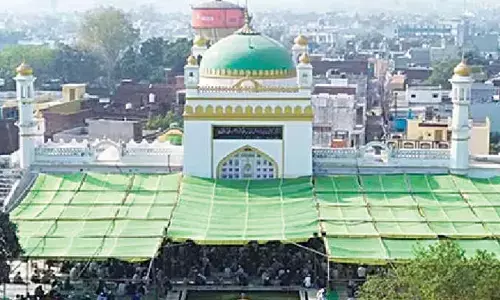Taj city's mega plantation drive despite water-space issues

Taj city’s mega plantation drive despite water-space issues
While there is more than enough space for paper trees planted in official files, there is hardly any space left on the ground for planting crores of saplings during the special tree plantation fortnight that begins from July 1 in Uttar Pradesh.
While there is more than enough space for paper trees planted in official files, there is hardly any space left on the ground for planting crores of saplings during the special tree plantation fortnight that begins from July 1 in Uttar Pradesh.
Come July, all the state government agencies, NGOs, green-warrior -outfits and nature lovers join the ritualistic tree plantation drive with pompous claims about the number of saplings planted.
If you add up all the claims of tree plantation work each year since 1990 by successive state governments, there would be hardly an inch of space left for planting new saplings. UP's green cover is hardly 10 per cent and with new mega projects coming up everywhere, film city, International Airport, expressways, residential urban clusters, shopping complexes, the space for extending green cover is severely limited, say retired horticulturists in Agra. A group of green activists in Agra has demanded an independent audit of the greening work done so far. This year too, the Yogi Adityanath government in UP has set ambitious targets for all government departments which will be supported by countless number of voluntary agencies.
Cynics are however asking where is the space left and who will take care of the tender saplings planted. The crude reality is that despite crores of saplings being planted each year, the survival rate is dismally poor. "They will come with all fanfare, plant saplings, get photographed and then forget," lamented Surendra Sharma, president of the Braj Mandal Heritage Conservation Society. The fact is that these are paper trees to be found in government files, he added. In 2016, former chief minister Akhilesh Yadav set a Guinness world record for planting 50 million saplings in a day. The green cover in Uttar Pradesh remains a dismal 9 per cent, against the national target of 33 per cent.
Experts say that for 90 million saplings, we need 2,25000 hectares of land, if the distance between two saplings is kept 5 metres. The Akhilesh Yadav government planted 50 million. So now where's the space? Even if the saplings are planted, who will take care of them?
One alternative is to use the riverbanks, suggests Agra's passionate tree lover Vinita Mittal. The road dividers could be used, as also the two sides of the roads along pavements, if there is space and provision for regular watering for a few years. "By creating green belts along rivers, any number of saplings can be planted. The survival rate of such saplings too can be high as the plants will get the required moisture from the nearby river-bed," says Mittal.
The eco-sensitive Taj Trapezium Zone, spread over 10,400 sq km, has seen continuous denudation of forest cover due to massive construction activity. Actually thousands of acres of fertile land which had a green cover have been gobbled up by newly constructed expressways and highways. The Yamuna and Agra-Lucknow expressways, dozens of flyovers, the inner city ring road and widening of the National Highway to Delhi have gobbled up acres of green cover, exposing the Taj Mahal to dust-laden winds from Rajasthan desert, says environmentalist Devashish Bhattacharya. "On the one hand they plant saplings, and on the other hand they are destroying green foliage along the Yamuna bank, to lay pipelines. We have complained to all but there is no response, Bhattacharya complained. Bhattacharya said that the Supreme Court had directed that a green buffer zone be created to insulate the historical monuments, but new road construction projects are being promoted by vested interests in the dense forests along the Agra Delhi highway, in the Keitham reserve forest area. It is a sad fact that despite continued focus on controlling the ecological apocalypse, there has not been much improvement over the years. Last year, the state government had fixed a target of some 20 crores. The volunteers hastily planted saplings everywhere recklessly. The result was that after two days most either got uprooted or died. The Agra municipal Corporation planted thousands of saplings on the Yamuna river bed, and they were all swept away when the water level went up during the monsoon Rains.
"The real problem with such over-hyped campaigns is that these are not backed by adequate support services that can take care of the plants for three years at least," activist Ranjan Sharma added.
(The views expressed are personal)














